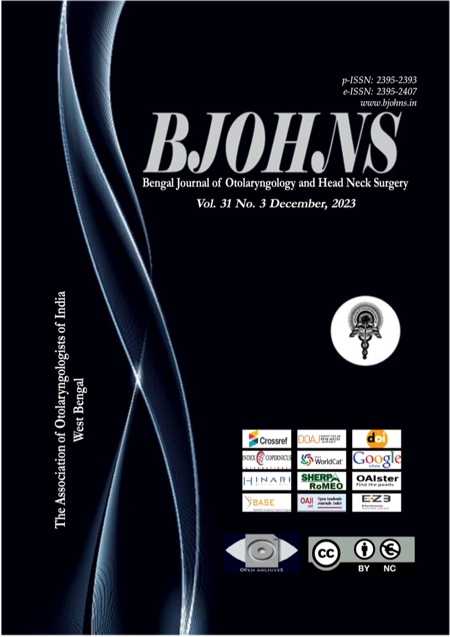Choanal Atresia: Clinical Features and Factors Affecting Its Surgical Outcomes
Main Article Content
Abstract
Introduction: One of a rare congenital anomaly seen in the development of nose is choanal atresia, whose occurrence is 1 in 5000-8000 live births. This study highlights our experiences in the management of choanal atresia.
Materials and methods: It is a retrospective study, which includes the systematic analysis of case files of patients who underwent surgical treatment for choanal atresia from the year 2015 to 2022.
Results: Total of 11 cases (15 operated sides) which has 9 female (53%) and 8 male (47%). Majority of them were bony atretic plate (10) followed by mixed variety (5) and none purely membranous. Age at 1st surgery in bilateral cases ranged from 6th day of life to 18th day of life. For unilateral cases the age at 1st surgery ranged from 26th day of life to as late as 10 years old.
Conclusion: Management of choanal atresia involves multi-disciplinary approach and preventing restenosis is a challenge. Factors effecting the outcome of surgery are age and weight of the child, as bigger the child in size, wider the choanal arches can be opened with less post-operative scarring and restenosis. Usage of nasopharyngeal airway as a stent in primary repair during early post-operative period is essential to stabilize the nasal airway.
Article Details

This work is licensed under a Creative Commons Attribution-NonCommercial 4.0 International License.
How to Cite
References
Eladl HM, Khafagy YW. Endoscopic bilateral congenital choanal atresia repair of 112 cases, evolving concept and technical experience. International journal of pediatric otorhinolaryngology. 2016 Jun 1;85:40-5
Moreddu E, Rossi ME, Nicollas R, Triglia JM. Prognostic factors and management of patients with choanal atresia. The Journal of pediatrics. 2019 Jan 1;204:234-9
Kwong KM. Current updates on choanal atresia. Frontiers in Pediatrics. 2015 Jun 9;3:52
Wormald PJ, Zhao YC, Valdes CJ, Pacheco AE, Ha TN, Tewfik MA, Wabnitz D, Shaw CK. The endoscopic transseptal approach for choanal atresia repair. InInternational forum of allergy & rhinology 2016 Jun (Vol. 6, No. 6, pp. 654-660).
Kurosaka H. Choanal atresia and stenosis: Development and diseases of the nasal cavity. Wiley Interdisciplinary Reviews: Developmental Biology. 2019 Jan;8(1):e336
Gupta M, Kour C. Congenital bilateral choanal atresia: A rare case. Journal of Rare Disorders: Diagnosis & Therapy. 2017;3(2):9. DOI: 10.21767/2380-7245.100162
Saafan ME. Endoscopic management of congenital bilateral posterior choanal atresia: value of using stents. European Archives of Oto-Rhino-Laryngology. 2013 Jan;270(1):129-34. DOI 10.1007/s00405-012-1956-0
Ibrahim AA, Magdy EA, Hassab MH. Endoscopic choanoplasty without stenting for congenital choanal atresia repair. International journal of pediatric otorhinolaryngology. 2010 Feb 1;74(2):144-50
Newman JR, Harmon P, Shirley WP, Hill JS, Woolley AL, Wiatrak BJ. Operative management of choanal atresia: a 15-year experience. JAMA Otolaryngology–Head & Neck Surgery. 2013 Jan 1;139(1):71-5
Brihaye P, Delpierre I, De Villé A, Johansson AB, Biarent D, Mansbach AL. Comprehensive management of congenital choanal atresia. International journal of pediatric otorhinolaryngology. 2017 Jul 1;98:9-18
Moreddu E, Rizzi M, Adil E, Balakrishnan K, Chan K, Cheng A, Daniel SJ, de Alarcon A, Hart C, Hartnick C, Inglis A. International Pediatric Otolaryngology Group (IPOG) consensus recommendations: diagnosis, pre-operative, operative and post-operative pediatric choanal atresia care. International journal of pediatric otorhinolaryngology. 2019 Aug 1;123:151-5
Kim H, Park JH, Chung H, Han DH, Kim DY, Lee CH, Rhee CS. Clinical features and surgical outcomes of congenital choanal atresia: factors influencing success from 20-year review in an institute. American journal of otolaryngology. 2012 May 1;33(3):308-12
Manica D, Schweiger C, Netto CC, Kuhl G. Retrospective study of a series of choanal atresia patients. International archives of otorhinolaryngology. 2014;18:002-5. DOI http://dx.doi.org/ 10.1055/s-0033-1358581. ISSN 1809-9777
Ramsden JD, Campisi P, Forte V. Choanal atresia and choanal stenosis. Otolaryngol Clin North Am 2009;42(2):339–352
Burrow TA, Saal HM, de Alarcon A, Martin LJ, Cotton RT, Hopkin RJ. Characterization of congenital anomalies in individuals with choanal atresia. Archives of Otolaryngology–Head & Neck Surgery. 2009 Jun 1;135(6):543-7
Navalakhe M, Chhabria S, Gaikwad N, Dwivedi V. Endoscopic transnasal repair of bilateral Choanal Atresia in Neonates: our experience. Int J Contemp Med Res. 2019;6(11):K4-7
Ayari S, Abedipour D, Bossard D, Froehlich P. CT-assisted surgery in choanal atresia. Acta oto-laryngologica. 2004 May;124(4):502-4
Carter JM, Lawlor C, Guarisco JL. The efficacy of mitomycin and stenting in choanal atresia repair: a 20 year experience. International journal of pediatric otorhinolaryngology. 2014 Feb 1;78(2):307-11.

